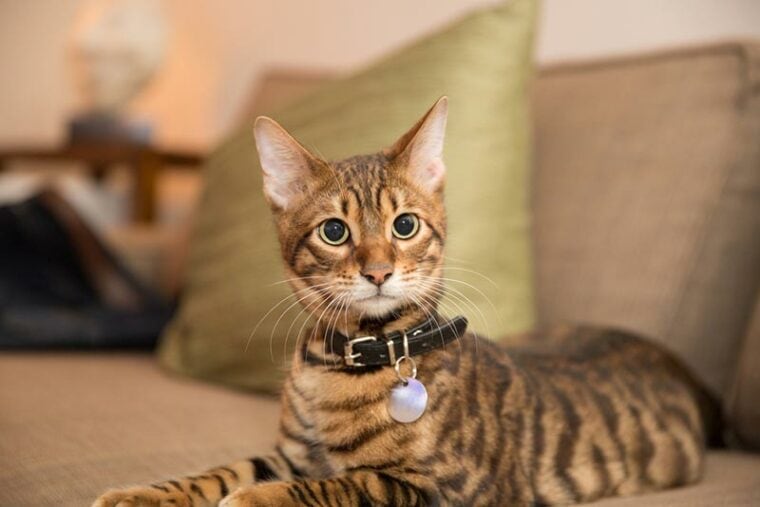
A cat collar can be used for identification and, if it has a bell, it can be used to protect local wildlife by warning the wildlife of an approaching predator. In some cases, cat collars can also contain magnetic or RFID chips that work with a cat flap and open the door automatically when the cat approaches.
However, cat collars can be dangerous if they’re too tight or too loose, and if they do not have a breakaway buckle that will snap if the collar gets caught on a branch or other object. Generally, you should be able to fit the ends of two fingers between the collar and your cat’s neck, which is a good sign that it’s loose enough to prevent rubbing and irritation but not so loose that it will snag on everything your cat passes.
Read on for more information on cat collars, including how best to measure your cat’s neck and even some tips on getting your cat used to its first collar.
How to Measure Your Cat’s Neck
Before buying a cat collar, you need to determine the size of your cat’s neck. Some companies sell collars according to a cat’s weight, but cats come in different sizes and shapes, so the best option to ensure that you get a good fit is to go by the actual measurement of the neck size. Use a fabric tape measure to directly measure the neck.
Ensure you measure snugly, but don’t pull the measure too tightly. If you don’t have a suitable measure, you can use a piece of string, put it snugly but not tightly around your cat’s neck, and hold the position where the string first overlaps. Take the string away and measure this using a ruler or tape measure. This will give the diameter of your cat’s neck and enable you to buy a collar that is designed for your cat’s neck girth.
Generally, you don’t need to be too precise with the measurement because most collars are adjustable and come with a generous range. If you find that your measurements fall exactly at the top or bottom of a given range, you can always look for a different collar that has a different range or be prepared to add an extra hole with a drill or other tool.
If your cat isn’t fully grown yet, you will need to buy another collar in a few months which means that you will have to take the measurement again. Alternatively, when you buy the first collar try to make sure there is at least some room to allow you to expand the size of the collar in the future.

How Tight Should The Collar Be?
You should be able to fit the ends of two fingers between the collar and the cat, without any gap. This will ensure that the collar does not rub against your cat’s neck or irritate its skin or coat. It also ensures that the collar isn’t so loose that it catches against branches, latches, and other hanging objects.
If your cat is still growing, check the fit of the collar every few weeks. Cats, especially very young cats, can grow very quickly, and if you don’t check the tightness of the collar, it could cause discomfort.
Breakaway Buckles
Most experts recommend that a collar has a breakaway buckle. These are designed so that if the collar becomes snagged on a branch or some other obstacle, the buckle will break when the cat struggles. It can prevent fatal accidents. While you will lose the collar, your cat will return unharmed.
Cats love to explore, but sometimes their curiosity can get them in trouble. The Hepper Breakaway Collar features a reliable breakaway buckle that will keep your cat safe and comfortable. The 100% natural hemp webbing is mold- and UV-resistant, and there's even an included jingle bell to keep your local wildlife safe!
At Pet Keen, we've admired Hepper for many years, and decided to take a controlling ownership interest so that we could benefit from the outstanding designs of this cool cat company!
How to Get Your Cat Used to Wear a Collar
Some cats find collars uncomfortable when first wearing them, and many dislike that initial feeling of something constricting being placed around their neck. If you are buying your cat its first collar and have struggled to get it to accept a new collar, try the following tips.
Conclusion
Cat collars can ensure lost cats are returned to their owners sooner. They can also help protect local wildlife and even provide access to an automatic cat door if you have one. But the collar needs to fit well, which means that it shouldn’t be too tight or too loose.
Measure your cat’s neck, choose a collar that is an appropriate size, and ensure that there is a gap of two fingers between the collar and the neck. Check the gap every month or so because the collar could tighten or loosen over time, and if your cat is still growing, its neck will likely grow, too.
Featured Image Credit: Stockelements, Shutterstock







